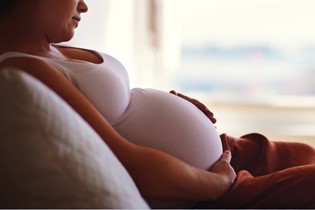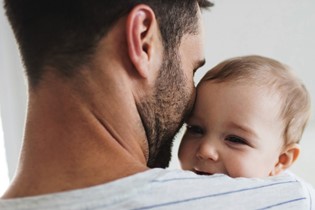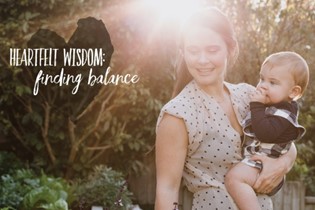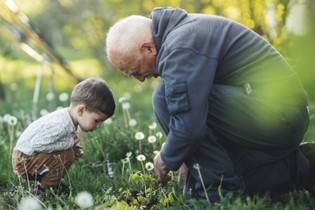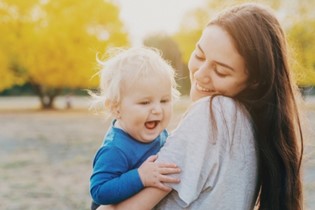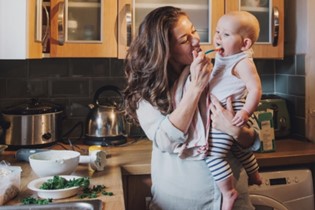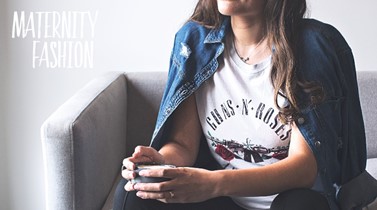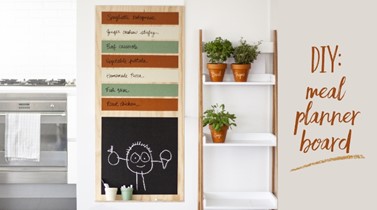Stand tall: tips for treating poor posture and neck pain
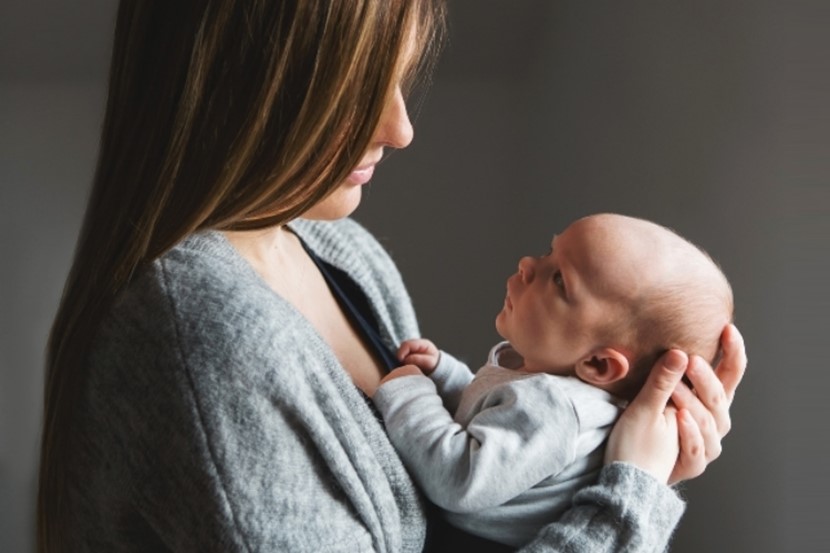
Osteopath Sarah-Jane Attias does some straight talking about neck pain and posture, and shares techniques and treatments for new mothers.
As a new mum, your neck and back may well be feeling ‘the pinch’, and simple things like sleep, pain-free movement and lashings of chilli are most likely a distant memory. Let’s face it, physically you feel like you have been to the moon and back, and your day-to-day family life is revolving in a new paradigm of blissful cuddles, neutral food and white noise.
From an osteopathic point of view, your postural horizon has drastically changed from an upright poised position, to looking down low while caring for baby and toddlers. Bending, swooping up, twisting and extra weight-lifting – that’s quite a workout! Bear in mind this workout is not an hour at the gym, it’s all day, every day. That old saying “Don’t use your back like a crane” may get a quick quip back – “Yeah, right!”.

BACK TO BASICS
Your natural primal body takes over when you’re pregnant: ligaments soften, bony joints ease, tissue stretches and hormones with many different tasks pulse throughout your whole system. After birth it’s re-set time: from your round-and-bearing body to a taller, linear one, and that, I can assure you from the experience of having treated many thousands of mums, is quite a journey. The good news is women have been doing this for thousands of years, and there’s lots of new knowledge, both medically and individually, as well as excellent recovery exercises you can do for yourself.
Neck pain is one of the most common issues we treat at our Osteopathic Mother, Baby and Toddler Clinic. When standing upright, your head is supported on top of your spine with an intricate web of muscles and ligaments – a real balancing act. Here’s a little insight: the average head weighs a whopping 4.5kg. However, when you look down at baby whilst breast- or bottle- feeding, the weight on your lowest neck joint increases dramatically – a phenomenal 27kg now hinges on that neck joint. Now add turning your head to look at baby’s face, and you can see where there is opportunity for strain, damage and pain. In addition to this, the tension is easily retriggered in our digital world, looking down at computers and mobile devices. Being tired and bending down into ‘baby world’ also agitates your neck and the groups of lower spinal muscles that support you.
THE INSIDE STORY
You can think of your diaphragm as the roof of your abdomen and your pelvic floor as the floor. Both are intricate muscle layers and their structures work together. Your diaphragm is not only the primary muscle for breathing, it also assists in holding your body upright, as it’s attached to your spine and ribs. The pelvic floor is a muscular sling from the pubic bone to the tailbone (coccyx). It works hard, contracting to hold everything in during pregnancy, and then at birth it reverses its role and expands for baby to travel through. Depending on baby’s exit, there may be intervention: an episiotomy, tearing and/or disruption of your tailbone.
After birth, the integrity of your pelvic floor needs to be re-established. Core exercises and pelvic tilts help. However, osteopathic treatment is an integral part of healing and reduction of associated symptoms, eg incontinence. If an osteopath felt, at any point, that further investigation was appropriate, they would refer you for an ultrasound or X-ray.
|
WHAT YOU CAN DO AT HOME TO PREVENT PAIN IN YOUR NECK, SHOULDERS AND UPPER BACK AREA ◻️ Set up a dedicated baby feeding area with an eye-level view out the window or gazing at a favourite picture on the wall. Make sure you have a supportive chair (with armrests) at the right height for you so that your feet are flat on the floor, or use a foot stool and pillows to fully support you and baby whilst feeding, cuddling and bonding. ◻️ Limber up for a minute before you start to feed: roll your shoulders, shrug them, shake your arms and extend them. Release the tension and get the blood flowing. When your baby has latched on and is comfortable, look up, and find your horizon in that view or picture you have set up. ◻️ Gradually breathe deeper and feel your shoulders relax. This allows space for your neck and aids the relaxation of all those muscles. As you relax, you may need to adjust your baby’s position – keep checking in with that level horizon.Check you’re not having to hold baby all the time. You’re a unit, and baby can feel your tension or relaxation and may respond accordingly. ◻️ Breathe into your lower abdomen. Imagine a small balloon just below your tummy button, gently inflating and deflating. Focus as you inhale through your nose: deep, gentle, rhythmic breaths, as this lifts the lower ribs, allowing the upper ribs to relax, which means the muscles of your neck also relax. |
BACK YOURSELF
It’s really important to be mindful; think about what you are going to do before you do it. Engage your pelvic floor and activate appropriate muscle groups before you lift and turn with carseats and buggies, for example. The retraining of your muscles and joint position will improve energy levels and sleep, as your body will be functioning better.
|
TECHNIQUES TO TRY AT HOME ◻️ Start from your feet up – invest in new comfortable fitness sneakers. ◻️ Carry spiky balls everywhere, as they’re especially good for rolling out tension in shoulder and buttock muscles, either up against a wall or on the floor. They’re great for rolling on the soles of the feet too, as they help to maintain foot mobility and reduce swollen ankles. ◻️ Liniments/muscle rubs. I recommend and stock Malcolm Harker Bruise Cream, which is completely natural and packed with arnica, chamomile and peppermint. ◻️ Pain relief (that is safe to take while breastfeeding) such as paracetamol – a great ‘bridge’ to get you through pain. ◻️ Hot and cold treatments as these improve the fluid dynamics of the problem area by reducing inflammation and swelling and improving lymph drainage and blood supply, promoting cells to heal faster. I recommend the following: ▪️ A wheat bag warmed in the microwave helps to relax and ease aching tired muscles, and they’re also comforting if placed on the lower belly. ▪️ Magnesium salts, commonly called Epsom salts, dissolved in a hot bath are like magic; magnesium soaks into your tissues and eases muscular tension. ▪️ Soft ice pack. Some respond well to heat, others to applying cold to the aching area. Then there’s contrast bathing, a mix of hot and cold, 10 minutes of each. |
When to ask for help
Stand in front of a long mirror. If you notice one of these warning signs, be sure to see your qualified specialist, such as an osteopath or physiotherapist.
⭐ Is one shoulder higher than the other? Is an elbow turned out?
⭐ Are you holding tight or slouching in the shoulders? We are usually unconscious of ‘the hump’ but you may spot slouching in a photo, or side-on in the mirror.
⭐ Are you standing balanced on two feet, or are you flicking your hips to one side? Locate the front bony point of your hip bone (they point out in front – I call them ‘headlights’). Are your headlights level?
⭐ Are your ankles rolling out? Look on the bottom of your sports shoes, and the wear and tear on specific areas will tell you which way you are inclining.
Some final advice: stand tall with your head up and your chin tucked in a little.
This will help improve your posture dramatically. It will make you look great and you will even seem to ‘grow’ a few inches! Also, don’t let your problems become long-standing issues. Osteopathy, in particular, has a very high success rate correcting neck and postural issues. And remember, every pre- and post-pregnancy experience is vastly different. Our bodies are all unique – one only needs to go to the beach on a hot day and look around to confirm that!
|
A HANDS-ON APPROACH Osteopaths specialise in releasing tension in the neck, shoulders and upper ribs, and the mid-back to lower spine and pelvis. We use gentle hands-on techniques: gently articulating joints and decompressing them; massaging and unwinding muscular tension and tissue; and rebalancing your head with the upper neck, lower back and both shoulders. This creates more space for your intervertebral discs, and the health-giving blood and nerve supply running through them reduces compression and inflammation, and provides pain relief. This helps ‘reset’ breathing function, encouraging rib and breast bone lift, and improving function of lymphatic drainage. |
|
Sarah-Jane Attias, BSc (Hons) Ost. London MONZ, is one of NZ’s most respected practitioners with 25 years’ experience. She enjoys Pilates, swimming, tramping and cycling – and the odd glass of red wine to power her way through life. At Living Osteopathy’s ‘Mother, Baby and Toddler Clinic’, they offer hands-on treatment as well as a step-by-step daily routine to rectify your posture and awareness at home. |
*Disclaimer: This article is for general information purposes only. If you have a specific health problem, you should seek advice from an appropriate registered health care provider. Living Osteopathy is a Primary Health Care Provider registered with ACC and the OCNZ. Living Osteopathy does not accept any liability other than to its clients.

AS FEATURED IN ISSUE 42 OF OHbaby! MAGAZINE. CHECK OUT OTHER ARTICLES IN THIS ISSUE BELOW


